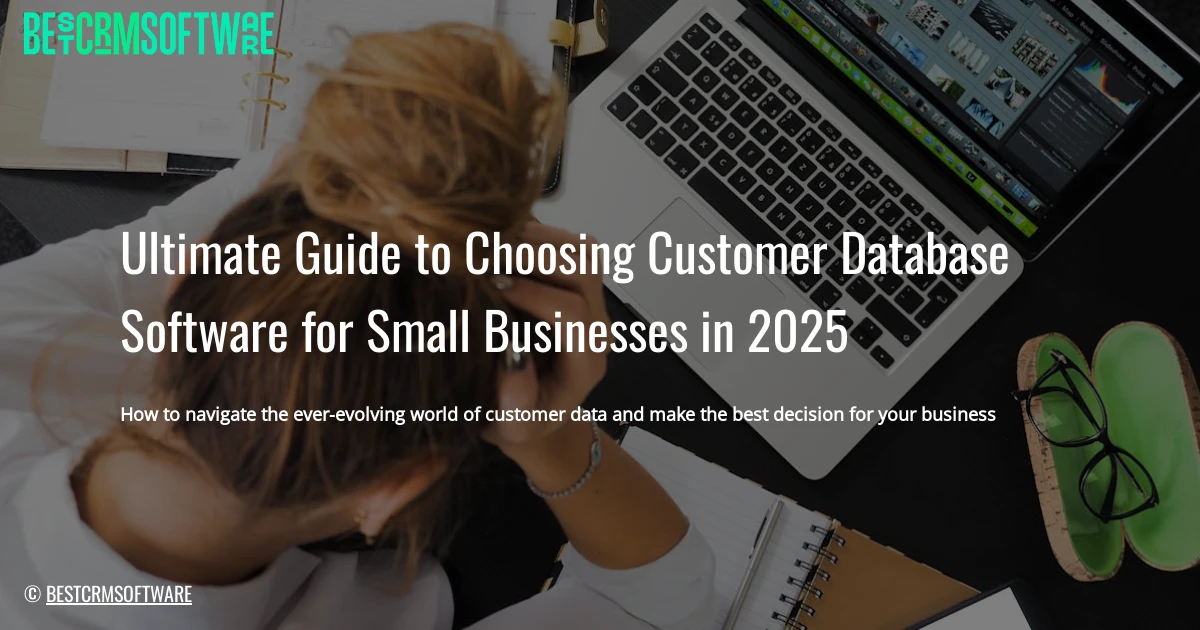How to navigate the ever-evolving world of customer data and make the best decision for your business
Introduction: Stepping into the Future of Customer Management
The world of customer data is undergoing a rapid transformation. As technology evolves and consumer expectations shift, small businesses need to navigate this ever-changing landscape to remain competitive. This ultimate guide aims to provide a comprehensive understanding of customer database software and its pivotal role in achieving sustainable success for small businesses in 2025.
Understanding the Evolving Landscape of Customer Data:
The way businesses collect, manage, and leverage customer data is rapidly changing. The traditional “data silos” are breaking down as companies strive for a holistic view of their customers. Emerging technologies like artificial intelligence (AI), machine learning (ML), and cloud computing are reshaping the way businesses interact with their customers, leading to more personalized experiences and impactful marketing campaigns.
Identifying the Need for a Dedicated Solution:
In this evolving environment, simply relying on spreadsheets and fragmented data systems is no longer sufficient. Small businesses require dedicated solutions – robust customer database software – to centralize and leverage their customer data effectively. A dedicated system enables organizations to capture crucial insights, improve customer interactions, and optimize their marketing efforts.
Defining Business Needs and Objectives:
Before embarking on the journey of choosing customer database software, it is vital to define your business needs and objectives clearly. What are your goals for customer engagement, sales, and marketing? Are you looking to personalize your interactions, automate marketing tasks, improve customer service, or gain a deeper understanding of customer behavior? By answering these questions, you can prioritize essential features and functionalities in your ideal software solution.
This comprehensive understanding forms the foundation for navigating the landscape of customer database software and choosing the ideal solution for your business needs. Let’s dive deeper into the core features, functionalities, and crucial considerations for choosing the right software to propel your business into the future of customer management.
Types of Customer Database Software: Navigating Your Options
Choosing the right customer database software is crucial for your small business’s success. There are numerous options available, and each comes with its own advantages and disadvantages. Understanding the differences between these options will help you narrow down your choices and select the best solution for your needs.
Here are two key distinctions to consider:
Cloud-Based vs. On-Premise Solutions
- Cloud-Based: Your customer data is stored on servers maintained by the software provider. You access it through the internet, via your web browser or a dedicated mobile app.
- Pros:
- Accessibility: Accessible from any device with an internet connection.
- Scalability: Easily scale your storage capacity and features as your business grows.
- Cost-Effective: Lower initial investment, often with subscription-based pricing models.
- Maintenance & Updates: Provider handles updates and maintenance, ensuring you have the latest version.
- Cons:
- Internet Dependence: Requires a stable internet connection to access the database.
- Security Concerns: Data is stored off-site, raising potential security concerns (although reputable providers offer robust security measures).
- Limited Customization: May have fewer customization options compared to on-premise solutions.
- Pros:
- On-Premise: You install the software on your own servers and manage data locally.
- Pros:
- Greater Control: Complete control over your data, including access levels and security.
- Customization: Extensive customization options, tailoring the software to your specific needs.
- Data Security: Data resides on your network, potentially offering better control over security measures.
- Cons:
- High Initial Cost: Significant initial investment in hardware, software licensing, and installation.
- Maintenance & Updates: Requires in-house IT resources to handle updates, maintenance, and security.
- Limited Accessibility: Access is usually limited to users on your local network.
- Scalability: Requires significant planning and investment for scaling the system as your business grows.
- Pros:
Open-Source vs. Proprietary Software
- Open-Source: Software code is publicly available, allowing anyone to modify or enhance it.
- Pros:
- Free (Usually): Typically free to use, download, and modify.
- Customization: Highly customizable, allowing developers to tailor it to specific needs.
- Transparency: Open-source code allows for transparency and collaborative development.
- Cons:
- Lack of Support: Often lacks formal support and might require developer expertise for troubleshooting.
- Security Concerns: Potential vulnerabilities in the code due to the open nature of its development.
- Limited Features: Might offer less comprehensive features compared to commercial software.
- Pros:
- Proprietary: Software code is privately owned and protected by copyright, requiring users to purchase a license.
- Pros:
- Comprehensive Features: Usually offers more extensive features and functionalities compared to open-source software.
- Dedicated Support: Comes with dedicated support and assistance from the software provider.
- Security Updates: Provider is responsible for ongoing security updates and patches.
- Cons:
- Higher Costs: Requires purchase of a license, with varying pricing models and support packages.
- Limited Customization: May have fewer customization options compared to open-source software.
- Vendor Lock-In: Can create dependence on the vendor for updates, support, and future developments.
- Pros:
By understanding these different options, small businesses can make informed decisions that align with their budget, technical expertise, and long-term goals. Remember to factor in specific features and functionalities, user-friendliness, and security considerations before committing to any particular type of customer database software.

© energepic.com
Essential Features to Look For: Building Your Ideal Software Suite
In today’s competitive landscape, a robust customer database software solution is more than just a fancy address book. It’s a strategic tool that can empower your small business to manage customer interactions, drive sales, and foster long-lasting relationships. To navigate this software jungle, understanding the key features is paramount. Here’s a breakdown of the essential ingredients for building your ideal software suite:
1. Contact Management (CRM): This is the bedrock of your database, storing valuable customer information. Look for features like:
- Centralized Database: Organize contact details, demographics, purchase history, preferences, and notes in one accessible platform.
- Contact Segmentation: Create targeted groups based on specific criteria for personalized communication and tailored offers.
- Lead Management: Capture leads from various sources, nurture them through the sales funnel, and track their progress effectively.
2. Sales Tracking & Management: Streamline your sales processes and increase revenue with features like:
- Pipeline Management: Visualize your sales opportunities, prioritize leads, and monitor progress in real time.
- Opportunity Tracking: Analyze each stage of the sales cycle and measure your team’s performance.
- Quote & Proposal Management: Create, track, and manage quotes and proposals efficiently.
3. Marketing Automation & Email Marketing: Enhance customer engagement and nurture relationships with:
- Automated Email Campaigns: Craft personalized email sequences, targeted newsletters, and trigger-based emails based on customer behavior.
- Campaign Analytics: Measure campaign performance, optimize strategies, and identify areas for improvement.
- Lead Scoring: Score and prioritize leads based on their engagement levels to target the most promising prospects.
4. Customer Support & Ticketing: Improve customer satisfaction and build trust through:
- Ticketing System: Manage support inquiries, prioritize issues, and track responses efficiently.
- Knowledge Base: Create a self-service resource library to answer common questions and empower customers.
- Live Chat: Provide instant support and engage with customers directly within your website or application.
5. Analytics & Reporting: Make informed decisions based on data insights with:
- Customizable Reports: Generate comprehensive reports on key metrics like sales performance, customer engagement, and marketing ROI.
- Data Visualization: Use interactive dashboards and charts to analyze trends, identify patterns, and gain deeper insights into customer behavior.
- Trend Analysis: Forecast future trends based on historical data and optimize strategies for continuous improvement.
6. Integrations: Connect your customer database software with other vital business tools like:
- E-commerce platforms: Integrate with your online store for a seamless customer experience.
- Social media: Sync with social platforms to streamline engagement and marketing campaigns.
- Accounting software: Streamline billing and payment processing.
7. Security and Compliance: Protect your valuable customer data and maintain trust:
- Data Encryption: Secure sensitive information with strong encryption protocols.
- Two-factor Authentication: Implement multi-factor authentication for increased account security.
- Compliance Certifications: Ensure your software adheres to relevant industry regulations like GDPR and CCPA.
Remember, the optimal software solution will align with your specific business needs and budget. Evaluating these essential features and exploring various options will enable you to make an informed decision and build a foundation for sustainable growth in 2025 and beyond.
Factors to Consider When Choosing Software: A Tailored Approach
Selecting the right customer database software can make or break your small business. To ensure you pick a system that fits your needs and supports your growth, consider these essential factors:
Understanding Your Business Size and Growth Trajectory
Your current business size and future growth projections heavily influence software choice. A system suitable for a fledgling startup may not handle the demands of a rapidly scaling business. Ask yourself:
- How many customers do you currently manage?
- How quickly is your customer base anticipated to grow?
- Are you planning any significant business expansions or changes?
A system designed for large-scale operations might be overkill for a smaller business, resulting in unnecessary costs and complexity. Conversely, an entry-level solution may prove restrictive as you expand. It’s best to select software that accommodates your current needs with the flexibility to scale along with your business growth.
Aligning Features with Your Specific Industry Needs
No two industries are the same, and your specific sector dictates your customer data needs and the features required to manage it. For example, a retail store requires different functionality compared to a professional services firm.
- Identify your core industry-specific challenges: What data points are critical for success in your industry?
- Explore feature sets: Compare software options and look for features that address your unique needs.
- Ask for tailored demonstrations: Request personalized product demonstrations focused on your specific industry requirements.
By focusing on industry-aligned solutions, you ensure your chosen software supports your day-to-day operations and offers meaningful insights into your target customer base.
Considering Future Scalability and Flexibility
While your current needs are paramount, it’s crucial to anticipate your business evolution. Opting for software with growth potential safeguards you from potential limitations down the road.
- Look for platforms with customizable options: This allows for flexibility to adapt to changing business requirements and unique processes.
- Consider integration capabilities: Seamless integration with existing tools and systems simplifies your workflows and ensures data consistency.
- Evaluate cloud-based options: Cloud-based systems offer inherent scalability, allowing for easy expansion as your business grows.
Remember, the right customer database software should not just manage data; it should act as a strategic asset for your small business. Choosing a system that anticipates your future needs while accommodating your present realities will drive growth, streamline operations, and maximize your customer engagement efforts.

© Jopwell
Preparing for Implementation: Setting the Stage for Success
Before diving into the world of customer database software, it’s crucial to have a solid plan for implementation. This section explores three key areas crucial for smooth and effective integration:
1. Defining User Roles and Permissions:
- Clarity is Key: Establish clear roles and responsibilities for accessing and manipulating data. Who needs full access to modify customer information? Who needs read-only access for specific data points? Define specific access levels to ensure data integrity and security.
- Role-Based Access Control (RBAC): Look for software with robust RBAC functionalities. This allows you to assign specific permissions to different roles, preventing unauthorized access and promoting data security.
- Avoid Data Silos: Consider potential departmental needs, such as sales, marketing, and customer support. Create workflows that seamlessly integrate data across different departments, preventing information gaps and fostering better collaboration.
2. Data Migration Strategies and Considerations:
- Plan your Transfer: Before implementation, develop a comprehensive strategy for transferring your existing customer data from your current system to the new platform.
- Data Cleansing: Thoroughly cleanse and validate existing data. Identify duplicates, incomplete records, and inaccurate information to ensure data quality in your new system.
- Data Mapping: Carefully map fields from your old system to the new one. This step is critical to prevent data loss and ensures consistent reporting across platforms.
- Utilize Third-Party Tools: If necessary, explore specialized data migration tools for efficient and reliable transfer. These tools often streamline the process, reducing the risk of errors and minimizing downtime.
3. Implementation Timelines and Resource Allocation:
- Establish a Realistic Timeline: Be realistic about implementation timeframes. Factor in data migration, training, and integration with other business systems.
- Dedicated Resources: Assign a dedicated project team to handle the implementation. This team should include IT personnel, stakeholders from key departments, and a project manager responsible for oversight.
- Internal Training: Prioritize training for all users. The training should focus on system functionalities, best practices for data entry, and understanding reporting capabilities.
- Vendor Support: Leverage your chosen vendor’s expertise during the implementation process. They can offer guidance, training resources, and technical assistance to ensure a smooth transition.
By meticulously planning for implementation, your small business can maximize the value of customer database software and experience a successful transition to enhanced customer engagement and data-driven decision-making.
Top Customer Database Software for 2025: A Curated List
Finding the right customer database software is crucial for small businesses aiming to grow and thrive in the digital landscape. This section dives deep into the two prominent categories: Cloud-Based Solutions and On-Premise Options, presenting a curated list of the top contenders for 2025.
Exploring Popular Cloud-Based Solutions
Cloud-based solutions offer several advantages, including scalability, accessibility, and cost-effectiveness. Here are some leading cloud options for your consideration:
- HubSpot: A comprehensive CRM platform boasting intuitive automation tools, robust email marketing features, and powerful analytics capabilities. Ideal for small businesses seeking to nurture leads and drive sales.
- Zoho CRM: Offering a robust feature set and seamless integration with other Zoho apps, this solution is a compelling choice for businesses with a diverse set of CRM needs.
- Salesforce Essentials: Tailored specifically for small businesses, Salesforce Essentials delivers essential CRM functions like lead management, opportunity tracking, and reporting, within an user-friendly interface.
- Pipedrive: A sales-focused CRM, Pipedrive excels at pipeline management and provides clear visualization of your sales funnel, making it a powerful tool for sales teams.
- Freshsales: Renowned for its easy-to-use interface and potent automation features, Freshsales enables small businesses to streamline sales processes and boost productivity.
Analyzing Leading On-Premise Options
On-premise solutions offer greater control over your data and system infrastructure. Here’s a rundown of some noteworthy on-premise options:
- Microsoft Dynamics 365: Offering advanced capabilities across sales, marketing, and customer service, Dynamics 365 caters to businesses seeking comprehensive CRM functionality and deep integration with Microsoft products.
- Sage CRM: A trusted solution known for its reliability and ease of implementation, Sage CRM provides robust tools for managing contacts, sales, and customer interactions.
- SAP CRM: Targeting larger organizations with complex business processes, SAP CRM provides a highly customizable and scalable platform to cater to your unique requirements.
- SugarCRM: An open-source platform offering extensive customization capabilities, SugarCRM empowers you to build a CRM solution perfectly tailored to your specific business needs.
Remember, this list is not exhaustive and other solutions might suit your unique requirements. Your best choice will depend on your budget, business needs, desired features, and preferred level of control over your data and infrastructure. The next section will equip you with the knowledge and tools to choose the perfect software for your small business.

© Jopwell
Cost of Ownership: Investing Wisely
Choosing the right customer database software is a crucial decision for any small business. Beyond functionality, a key aspect to consider is the cost of ownership, which can vary significantly based on the chosen software and your budget.
Key Considerations for Budgeting
- Initial Investment: This refers to the upfront cost of purchasing the software. It can include one-time license fees or the first month’s subscription fee. Consider your company’s current financial status and allocate a realistic budget for this initial expense.
- Ongoing Costs: After the initial purchase, ongoing costs can include:
- Monthly or annual subscription fees: Some software vendors offer subscription-based plans, which are usually more affordable than perpetual licenses in the short term.
- Maintenance and support fees: These can cover technical support, updates, and bug fixes.
- Additional features and integrations: You may need to purchase add-ons or integrations for specific functionalities that are not included in the base plan.
- Hidden Costs: Look for hidden fees or costs that may arise down the line. For example:
- Data storage and hosting: This might be charged separately depending on your chosen solution.
- Training costs: If you need professional training for your team, factor in these expenses.
- Return on Investment (ROI): It’s essential to calculate the ROI of your investment in customer database software. Think about how the software will help you increase revenue, save time, or improve customer engagement.
Understanding Pricing Models: Subscription vs. Perpetual Licensing
Subscription-Based Pricing:
- Pros:
- More affordable in the short term.
- Includes automatic software updates and maintenance.
- Often offers flexible plans to fit your changing needs.
- Cons:
- You pay recurring costs even if you stop using the software.
- You may be locked into a long-term contract.
Perpetual License Pricing:
- Pros:
- One-time purchase, eliminating recurring costs.
- Full ownership of the software.
- Cons:
- Higher initial cost.
- May require separate fees for maintenance and upgrades.
By carefully considering these pricing aspects, you can make a financially sound decision when choosing your customer database software. You’ll have a better understanding of your initial investment, long-term expenses, and the overall value the software provides for your small business.
Migrating From Existing Systems: A Seamless Transition
Importance of a Seamless Transition
Switching customer database software is a significant undertaking for any business, but particularly for small businesses with limited resources and time. A seamless transition is crucial to ensure minimal disruption to daily operations and avoid data loss or inaccuracies. A smooth migration allows your team to adapt quickly to the new system, maximizing efficiency and minimizing frustration.
Here’s why a smooth transition matters:
- Maintain customer relationships: A successful migration safeguards your customer data, allowing you to continue personalized communication and avoid losing valuable leads.
- Minimize downtime: A seamless transition minimizes interruptions to your business, ensuring you can continue serving customers without delays.
- Boost team morale: A smoother transition reduces stress on your team, allowing them to focus on core business activities rather than struggling with the new software.
- Ensure data accuracy: Careful migration practices help prevent errors and ensure your customer data remains reliable in the new system.
Strategies for Successful Data Migration
The success of your data migration heavily depends on thorough planning and execution. Here’s a roadmap to guide you:
1. Plan Your Strategy:
- Define clear goals and objectives: Outline your desired outcomes, including specific features and functionality expected from the new software.
- Identify and prioritize critical data: Analyze your current database and identify the essential customer information that needs to be migrated.
- Set a realistic timeline: Factor in the complexity of your database and allocate sufficient time for each stage of the migration.
- Create a backup plan: Implement comprehensive backups of your existing data as a safety net in case of unforeseen issues.
2. Prepare the Data:
- Data cleaning: Address any inconsistencies, duplicates, or outdated information within your existing database. This improves accuracy and efficiency in the migration process.
- Data mapping: Establish a clear link between your current data fields and the corresponding fields in the new software. This ensures data is transferred accurately.
- Choose your migration method: Determine whether you’ll perform the migration manually, utilize the software vendor’s tools, or leverage a third-party migration service.
3. Execute the Migration:
- Test migration in a staging environment: Run the migration on a separate system (a test environment) before implementing it in your live database. This minimizes risks and allows for adjustments.
- Monitor progress: Regularly check the migration’s progress and troubleshoot any errors immediately.
- Communicate with stakeholders: Keep your team informed about the migration’s status and address any concerns proactively.
4. Validate and Go Live:
- Post-migration verification: Thoroughly validate that all customer data has been transferred accurately and is accessible in the new software.
- Employee training: Conduct thorough training sessions for your team to familiarize them with the new software’s functionalities and features.
- Go live gradually: Consider starting with a phased approach, gradually migrating user groups or sections of data to reduce potential disruption.
By focusing on meticulous planning, preparing the data diligently, and implementing a methodical migration approach, small businesses can transition to new customer database software seamlessly. This ensures continued business operations, minimized disruption, and accurate, valuable customer information at their fingertips.

© Andrea Piacquadio
Data Security and Privacy: Protecting What Matters
Your customer database holds some of your most valuable assets – the information about your customers. Keeping this information safe and secure should be paramount. This means addressing two critical aspects: data integrity and accuracy and compliance with data protection regulations.
Ensuring Data Integrity and Accuracy:
- Data Validation: Look for software that implements data validation rules to catch errors as data is entered. This minimizes the chance of inaccurate data making its way into your database.
- Data Cleansing and Deduplication: Regularly cleansing your database removes duplicate entries, outdated information, and inaccurate data. Choose software with built-in tools or integrations for this process.
- Data Auditing: Regularly audit your database to ensure consistency and identify any inconsistencies or gaps in your data. Look for software with audit trails or reporting features to track data changes.
- User Permissions and Access Control: Control who has access to different parts of your database. Restrict access to sensitive information and track all user activity to prevent unauthorized changes.
Compliance with Data Protection Regulations:
- GDPR, CCPA, and Others: Understand the data protection laws relevant to your industry and geographic location (e.g., GDPR in Europe, CCPA in California).
- Data Encryption: Choose software that offers data encryption both at rest and in transit. This ensures the protection of sensitive customer data, even if your database is accessed by unauthorized parties.
- Data Deletion: Make sure the software allows for the secure deletion of customer data when requested. This complies with “right to be forgotten” provisions under various regulations.
- Privacy-Focused Features: Look for features like data masking, consent management, and data anonymization tools to comply with data privacy regulations.
Investing in the right customer database software for your small business should be a decision driven by both security and functionality. Choose a solution that allows you to leverage your customer data while keeping it safe, secure, and compliant with evolving regulations.
User Adoption and Training: Empowering Your Team
Choosing the right customer database software is only half the battle. You need to make sure your team can effectively use the tool to maximize its benefits. This is where user adoption and training come into play. Here’s how to empower your team and unlock the full potential of your chosen software:
1. Training Staff for Optimal Software Utilization:
- Focus on Practical Application: Training shouldn’t just be about learning software features. Demonstrate how these features can be used in real-world scenarios. For example, show how to create personalized campaigns based on customer segmentation data.
- Provide Hands-On Experience: Encourage interactive training where team members can practice using the software directly. This fosters familiarity and confidence.
- Offer Tailored Training: Different team members may have different needs and skill levels. Offer personalized training tracks or specialized workshops that address specific areas of interest.
- Create Easy-to-Follow Resources: Make sure your team has access to clear and concise user guides, video tutorials, and cheat sheets. These resources can be accessed anytime, even after formal training.
2. Providing Ongoing Support and Resources:
- Establish a Clear Support Structure: Designate a specific individual or team as the go-to for any questions or issues. Ensure there are multiple channels for support, including email, chat, or phone.
- Foster a Culture of Knowledge Sharing: Encourage team members to share tips and tricks with one another. This builds a collective knowledge base and encourages continuous learning.
- Regularly Monitor User Adoption: Keep track of user activity and identify areas where users struggle. This feedback can inform future training initiatives or feature updates.
- Provide Incentives for User Adoption: Offer rewards or recognition for individuals who consistently utilize the software. This can boost morale and promote adoption.
By investing in comprehensive training and ongoing support, you’ll ensure that your team feels comfortable and confident using the customer database software. This leads to increased efficiency, higher productivity, and ultimately, a stronger relationship with your customers.

© Andrea Piacquadio
Tracking Success: Analytics and Reporting
Choosing the right customer database software isn’t just about storing data; it’s about gaining actionable insights that drive your business forward. This is where powerful analytics and reporting features become crucial. Here’s how they play a vital role in turning your database into a growth engine:
1. Measuring Key Performance Indicators (KPIs):
- Identify What Matters: Your software should allow you to track crucial metrics relevant to your specific business goals. This might include things like customer acquisition cost (CAC), customer lifetime value (CLTV), conversion rates, churn rates, email open and click-through rates, and engagement levels on your website or social media.
- Benchmark and Analyze: Don’t just collect data, understand it. The ability to create custom reports, filter data by segments, and compare your performance over time helps you identify trends, pinpoint areas for improvement, and measure the success of your marketing campaigns.
2. Utilizing Data to Improve Business Processes:
- Optimize Marketing Strategies: Analyzing customer interactions reveals insights into which marketing channels are most effective, who your ideal customers are, and what resonates with them. Use this data to tailor your marketing campaigns for maximum impact and better allocate your budget.
- Personalize the Customer Experience: Leverage customer data to personalize offers, recommendations, and communications. Knowing what customers have purchased, their browsing history, and their preferences allows you to deliver more relevant and engaging experiences, improving customer satisfaction and loyalty.
- Identify Opportunities: By analyzing customer data, you can uncover untapped opportunities. Perhaps you discover a niche group of high-value customers, or a specific product or service that resonates unexpectedly well. These insights help you fine-tune your offerings and strategies for optimal growth.
- Predict Future Outcomes: Advanced analytics features, such as predictive modeling, can help anticipate future trends and behaviors. This enables you to proactively address potential problems, identify potential customers, and optimize inventory levels for greater efficiency.
**In essence, the right analytics and reporting tools turn data into a powerful weapon for driving your small business towards success. **
Maximizing Value: Integrations and Extensions
Your customer database is the heart of your business operations. To truly maximize its potential, you need a system that seamlessly connects with the other tools you use daily. This is where integrations and extensions come into play.
Here’s how strategically chosen integrations can unlock tremendous value for your small business in 2025:
1. Integrating with Marketing Automation Tools:
- Effortless Lead Nurturing: Connect your database to marketing automation platforms like Mailchimp, HubSpot, or ActiveCampaign to automate email campaigns, personalized content, and lead nurturing journeys.
- Data-Driven Campaigns: Segment your audience based on purchase history, demographics, and engagement levels within your database to create targeted and effective marketing campaigns.
- Track and Analyze Performance: Gain insights into campaign performance by analyzing email open rates, click-throughs, and conversions directly from your database, allowing for continuous improvement.
2. Connecting with Sales & CRM Systems:
- Unified Customer View: Connect your database to a CRM system like Salesforce or Zoho to gain a comprehensive view of each customer’s interactions across different channels.
- Efficient Lead Management: Automatically route leads from your database to your sales team based on specific criteria, ensuring no opportunity is missed.
- Enhanced Communication & Collaboration: Streamline communication with customers across your entire sales process, sharing data, notes, and updates seamlessly.
3. Streamlining Operations with Accounting & ERP Software:
- Automated Data Transfers: Eliminate manual data entry by connecting your customer database with your accounting software (e.g., QuickBooks) or ERP system (e.g., NetSuite).
- Accurate Billing and Invoicing: Update customer contact information, purchase history, and payment details in your accounting software automatically from your database.
- Real-Time Inventory Management: Connect your database to your inventory management system to track customer purchases and ensure accurate inventory levels.
Key Considerations for Choosing Integrations:
- Ease of Use: Look for solutions with intuitive interfaces and clear documentation that allow for smooth data exchange between systems.
- Security & Data Privacy: Ensure your chosen integration adheres to strict data security measures to protect customer information.
- Cost-Effectiveness: Weigh the benefits of each integration against its cost and choose solutions that align with your budget.
By choosing a customer database solution with robust integration capabilities, you can unlock a powerful ecosystem that streamlines your workflows, maximizes efficiency, and ultimately helps you grow your business.

© Anna Shvets
Staying Ahead: The Future of Customer Database Software
The landscape of customer data management is in constant flux, driven by evolving technologies and consumer expectations. Small businesses looking to harness the power of customer data must remain agile and understand the future trends shaping this space. This requires not only selecting the right software but also adapting to the evolving technological landscape.
Understanding Future Trends in Customer Data Management:
- AI-powered insights: Expect increased use of artificial intelligence to glean valuable insights from your customer database. AI will automate tasks like customer segmentation, personalization, and even predict future customer behavior.
- Data privacy and compliance: As regulations like GDPR become more stringent, choosing software compliant with data privacy laws will be crucial. Look for solutions offering built-in features for data security, access controls, and clear consent management.
- Omni-channel integration: Your customers interact with your brand across multiple platforms – from websites and apps to social media and email. Choose software that can unify customer data from all channels for a comprehensive understanding.
- Personalized experiences: Customers crave tailored experiences. Look for software that can automate personalized communications based on their individual preferences, purchase history, and interactions.
- Data visualization and reporting: Effective decision-making relies on clear data visualization and reporting. Choose software with intuitive dashboards and the ability to generate actionable reports on customer engagement and trends.
Adapting to the Evolving Technological Landscape:
- Cloud-based solutions: The trend towards cloud computing will continue, offering scalability, cost-effectiveness, and easy accessibility. Opt for a cloud-based customer database software for flexibility and future-proofing.
- API integrations: Choosing software with open APIs will allow seamless integration with other tools your business relies on – marketing automation platforms, e-commerce platforms, etc. This ensures your data flow smoothly and seamlessly between systems.
- Data governance and security: Investing in robust security features, including data encryption and two-factor authentication, will safeguard your valuable customer data against potential threats.
- Regular updates and enhancements: Choose a vendor that continuously updates its software with the latest features and security patches to stay ahead of evolving data security challenges.
By understanding the future trends in customer data management and actively adapting to the evolving technological landscape, small businesses can future-proof their customer data strategies and harness the power of their data to drive growth and customer satisfaction in the years to come.
Case Studies: Real-World Success Stories
While the theoretical benefits of customer database software are compelling, real-world success stories truly highlight its power. Here are two examples illustrating how small businesses leverage these tools for impactful results:
1. The Power of Customer Segmentation for Targeted Marketing:
Company: A small artisanal bakery with a loyal following but struggling to reach new customers.
Challenge: Difficulty identifying and reaching specific demographics for their baked goods.
Solution: Implementing a customer database software allowed them to segment their existing customer base based on purchase history, demographics, and preferred product categories. They then launched targeted marketing campaigns via email and social media, offering promotions specifically designed for each segment.
Results: The bakery experienced a 20% increase in new customer acquisition, a 15% increase in average order value, and a significant boost in overall revenue.
Key Takeaways:
- Customer segmentation enabled the bakery to deliver personalized offers, increasing engagement and conversions.
- Utilizing customer data for targeted campaigns maximized marketing ROI and reached relevant audience groups.
2. Enhancing the Customer Journey Through Personalized Experiences:
Company: A local boutique specializing in handmade clothing and accessories.
Challenge: Building brand loyalty and creating a memorable customer experience in a competitive market.
Solution: They adopted a customer database software that captured detailed purchase history, browsing behavior, and preferences. This data fueled personalized recommendations, tailored email campaigns, and targeted social media ads.
Results: Customers felt valued and engaged through personalized shopping experiences. Increased customer satisfaction led to a 25% rise in repeat purchases and a 10% increase in referral sales.
Key Takeaways:
- Using data to personalize customer interactions strengthens brand loyalty and drives repeat business.
- Tailoring customer journeys with relevant offers and recommendations enhances their shopping experience.
These case studies demonstrate the immense potential of customer database software for small businesses. By leveraging customer insights and personalizing the customer journey, small businesses can compete effectively, boost revenue, and cultivate long-lasting relationships with their customers.

© Anna Shvets
Customer Feedback and Iterative Improvement
Importance of Gathering User Feedback
As your small business grows, gathering user feedback becomes paramount to continuous improvement. This doesn’t just apply to your product or service but also your customer database software. By understanding the needs and experiences of your users, you can ensure that the software seamlessly integrates with your workflows and provides the features that matter most. This feedback can be gathered through a variety of channels like:
- In-app surveys: Directly ask users about their experiences within the software.
- Customer support interactions: Analyze feedback received through emails, chats, or phone calls.
- Focus groups: Organize focused discussions with select users to gather deeper insights.
- User forums and social media: Monitor online platforms where users share their experiences.
Leveraging Customer Insights for Product Development
The insights gathered through user feedback become invaluable in informing your product development strategy. Here’s how you can utilize these insights to enhance your customer database software:
- Prioritize feature requests: Identify recurring themes and prioritize features that address the most frequent pain points of your users.
- Optimize user interface: Use feedback to refine the layout and functionality, making the software intuitive and easy to use.
- Enhance integration with other tools: Ensure seamless connections with other software used within your business to streamline processes.
- Improve customer support: Use feedback to enhance training materials, knowledge base articles, and communication protocols, ultimately improving support efficiency.
By actively soliciting and incorporating user feedback into your customer database software development, you ensure a tool that truly supports your small business’s success. This iterative approach keeps your software aligned with evolving needs, drives user engagement, and ultimately boosts your overall business performance.
Troubleshooting and Support: Navigating Roadblocks
Common Challenges Faced by Small Businesses:
While choosing the right customer database software can be a boon for small businesses, the journey isn’t always smooth sailing. Here are some common challenges:
- Data Import Issues: Moving existing customer data into the new system can be tricky. Different software platforms may have incompatible data formats, leading to errors and inaccuracies.
- Integration with Existing Systems: Seamless integration with existing tools like email marketing platforms or CRM systems is crucial. Incompatible software can lead to manual data entry and increased workload.
- Training and Adoption: Small businesses often have limited time and resources for staff training. Difficult-to-use interfaces can hinder adoption and utilization of the software.
- Technical Glitches: Software bugs and downtime can disrupt operations, potentially causing data loss or hindering critical processes.
- Scalability Issues: As businesses grow, the software’s capabilities might not keep up with expanding needs, requiring upgrades or new solutions.
Practical Tips and Best Practices for Success:
- Focus on Comprehensive Support: Choose software with readily available customer support through phone, email, live chat, and a comprehensive knowledge base.
- Data Import Assistance: Seek providers who offer assistance with data migration and ensure the process is smooth and accurate.
- User-Friendly Interface: Prioritize user-friendly interfaces that require minimal training, simplifying adoption and increasing staff comfort.
- Look for Built-in Integrations: Choose a software that integrates with other crucial business systems for seamless workflow.
- Scalability & Flexibility: Invest in software that scales with your business needs and allows for customization to adapt to changing requirements.
- Utilize Online Resources: Leverage community forums, online documentation, and tutorial videos to quickly resolve minor issues and gain deeper understanding of the software.
Remember, investing in reliable and supportive software will ultimately ease the challenges of managing your customer database, enabling you to focus on what truly matters: building your business and delivering exceptional customer experiences.

© Andrea Piacquadio
Going Beyond the Basics: Advanced Features & Future Trends
As your small business grows, your CRM needs to evolve with it. Beyond fundamental contact management, you’ll likely want to leverage advanced features that unlock deeper insights and automated actions. Here are two areas to focus on:
Exploring Advanced Features for Data Enrichment:
- Data Synchronization & Integration: Integrate your customer database with other business systems like e-commerce platforms, accounting software, or marketing automation tools. This creates a single source of truth for your data and enables seamless data flow across your operations.
- Data Cleaning and Standardization: Automated data cleaning features help ensure accurate and consistent information. They identify and correct errors, standardizing formats and ensuring data integrity.
- Data Append & Enrichment: This involves adding crucial information to your existing contact records, such as demographics, firmographics, and purchasing behavior. This rich data helps you segment customers more effectively and personalize your outreach.
- Real-time Data Tracking: Stay on top of dynamic information. Track website visits, engagement with emails, social media interactions, and other key touchpoints in real time. This gives you an accurate picture of customer behavior.
Utilizing AI and Machine Learning for Predictive Analysis:
- Predictive Scoring & Segmentation: Leverage AI to predict customer churn, identify high-value leads, and personalize marketing efforts based on individual customer behavior patterns.
- Automated Recommendations & Personalization: Utilize AI to generate personalized product or service recommendations based on individual customer preferences and past interactions. This boosts customer satisfaction and drives conversions.
- Proactive Outreach and Support: AI-powered tools can help you anticipate customer needs and provide proactive support before issues arise. This enhances customer experience and improves retention rates.
- Market Trend Analysis: AI can analyze market data to uncover emerging trends and customer preferences, enabling you to stay ahead of the curve with your products and services.
Looking to the Future:
In 2025 and beyond, customer database software will become even more intelligent and integrated. Expect:
- Greater Emphasis on Data Privacy and Security: Businesses will prioritize tools with robust data encryption and access controls to protect customer information.
- Omni-Channel Customer Engagement: Software will seamlessly manage interactions across various channels like websites, social media, mobile apps, and live chat, providing a unified customer experience.
- Increased Automation & AI: Expect further advancements in AI-powered automation, with systems becoming more capable of managing routine tasks and making informed decisions on your behalf.
By embracing these advanced features and trends, small businesses can unlock new opportunities for growth and customer satisfaction.
Conclusion: Empowering Growth with the Right Software
Choosing the right customer database software isn’t just about finding a tool that works; it’s about finding one that aligns perfectly with your business goals and fuels your growth strategy. As we’ve explored, there are a plethora of options, each tailored to specific needs.
By understanding your unique business model and adopting a customer-centric approach, you can unlock the true potential of a well-chosen database software.
- Choosing the Right Software for Your Unique Business Model: Don’t settle for a one-size-fits-all solution. Analyze your industry, target audience, and sales process. A software tailored to your needs will offer specific features that empower your team and streamline your operations. This might mean prioritizing sales automation for a high-volume business or emphasizing CRM for a service-focused enterprise.
- Building Long-Term Value with a Customer-Centric Approach: Ultimately, the best customer database software will help you understand and cultivate meaningful relationships with your customers. Use it to collect and analyze data that reveals insights into their preferences, buying behavior, and overall journey. This allows you to provide personalized experiences, anticipate their needs, and ultimately increase their lifetime value to your business.
By embracing these principles, your chosen software won’t just be a tool—it will be a powerful ally driving your business to greater success in the years to come. Don’t just collect data; use it to understand, engage, and build lasting customer loyalty.

© Andrea Piacquadio
Appendix: Resources and Further Reading
Glossary of Key Terms: Understanding the Terminology
Before you begin your journey to finding the perfect customer database software, it’s essential to familiarize yourself with the key terminology. Here’s a glossary of common terms used in this guide:
CRM (Customer Relationship Management): Software used to manage all interactions with current and potential customers.
Customer Database: A structured collection of information about your customers, including contact details, purchase history, preferences, and more.
Database Management System (DBMS): Software used to create, maintain, and access databases.
Data Integration: The process of combining data from different sources into a unified system.
API (Application Programming Interface): A set of rules that allow different software applications to communicate with each other.
Automation: Using software to automate repetitive tasks, such as sending emails or scheduling appointments.
Segmentation: Dividing your customer base into smaller groups based on shared characteristics, enabling targeted marketing and personalized experiences.
Reporting and Analytics: Tools that help you visualize and analyze customer data to gain insights and make better business decisions.
Cloud-Based: Software hosted on remote servers and accessed through the internet.
On-Premise: Software installed and run on your own company’s servers.
Mobile Compatibility: The ability to access and manage your customer database from mobile devices.
Scalability: The software’s ability to grow and handle increasing volumes of data and users.
Integrations: The ability to connect the software with other business tools and applications, like email marketing platforms or accounting software.
Security: Measures taken to protect customer data from unauthorized access and cyber threats.
By understanding these key terms, you’ll be better equipped to make informed decisions when evaluating different customer database software options.
About Us: Your Trusted Guide in the Digital Age
Navigating the ever-evolving landscape of technology can feel overwhelming, especially for small businesses with limited resources and time. That’s where we come in! We’re dedicated to providing you with clear, concise, and actionable information to help you make the best decisions for your business.
Our mission is to empower small businesses with the knowledge and tools they need to succeed in the digital age. We believe that access to the right information can level the playing field and enable any business to thrive, regardless of size.
Here’s how we help:
- Simplifying Complexity: We break down complex topics into easy-to-understand explanations, eliminating industry jargon and technical complexities.
- Curating Relevant Content: We carefully select resources and tools that are specifically tailored to the needs of small businesses.
- Staying Updated: We are committed to providing you with the latest trends and best practices in customer database software and related technologies.
- Focus on Value: Our goal is to offer information that is practical, insightful, and directly applicable to your daily operations.
We’re confident that with the information you gain here, you’ll be able to make informed decisions about customer database software and cultivate thriving customer relationships that fuel your business growth.

© Andrea Piacquadio
Resources
10 BEST CUSTOMER DATABASE SOFTWARE FOR A SMALL BUSINESS (2024)
THE BEST SMALL BUSINESS SOFTWARE IN 2024: OUR EXPERT GUIDE
WHY YOU NEED A CRM FOR YOUR SMALL BUSINESS – INNOVATIVE FLARE
BEST CRM SOFTWARE TOOLS FOR SMALL BUSINESS IN 2024 – SELECTHUB
15 BEST CRM SOFTWARE IN 2024 – RESEARCH.COM
HOW TO CHOOSE THE BEST SOFTWARE FOR YOUR SMALL FIRM – YOUTUBE
<!–
–>

